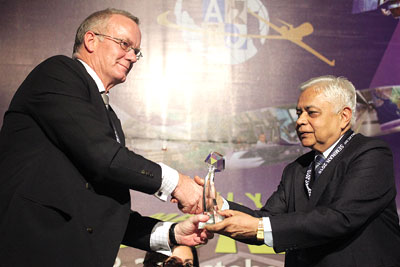ATM - Managing Air Traffic

The seminar provided a platform for deliberations on a wide range of subjects that focused on developing India as an aviation business hub
The Air Traffic Controllers’ (ATC) Guild (India) organised a two-day seminar on October 20 and 21, 2010 at the India Habitat Centre, New Delhi on the subject “Air Traffic Management (ATM), Airports and Airlines: India Initiatives for Infrastructure”. October 20 being celebrated as the World Air Traffic Controllers’ Day, the timing of the seminar was significant. The ATC Guild (India) has been a member of the 137-nation International Federation of Air Traffic Controllers’ Associations (IFATCA) since 2005, and it was only appropriate that Alexis Brathwaite, President and Chief Executive Officer at IFATCA, Trinidad and Tobago, was the guest of honour. SP Guide Publications was a corporate sponsor for the seminar.
The seminar provided a platform for deliberations on a wide range of subjects that focused on developing India as an aviation business hub. The topics included capability in the regime of aerospace manufacturing, next-generation ATM systems and policy framework. The aviation sector in India is expected to register the highest rate of growth in Asia and the seminar facilitated an exchange of ideas on the importance and impact of infrastructure on the growth of the industry. The participants in the seminar included Civil Aviation Minister Praful Patel who was the chief guest, Director General of Civil Aviation (DGCA) Dr Nasim Zaidi, Chairman of Airports Authority of India (AAI) V.P. Agrawal, Airports Economic Regulatory Authority (AERA) Chairman Yashwant Bhave and former Secretary Civil Aviation and Senior Advisor Aviation Watch Ajay Prasad.
In his inaugural address, the Civil Aviation Minister stated that the dynamic and evolving aviation sector in the country had made the task of air traffic management not only extremely complex but difficult as well and that the government would provide all the support needed by the organisation. With the commissioning of new airports and enhancement of the capacity of existing airports in the country, Indian skies were getting busier and hence there was an urgent need to put in place better systems/infrastructure. Undoubtedly, there would be many challenges ahead in achieving this aim. While commending the Air Traffic Controllers for managing the skies safely, despite technological deficiencies, the Minister said that air safety rested largely on the able shoulders of those who managed the ATM systems. He stated that upgradation and modernisation of communication, navigation and surveillance (CNS) systems had been given top priority. The GAGAN programme had entered the trial phase and is expected to be fully operational by 2013. Stating that GAGAN would make a big difference in CNS, he added that India will be the fourth country in the world to possess this capability.
With regard to the shortage of Controllers, he said that while the regular induction programme was on, there was thought of employing retired Controllers on contract basis. “Frequent reports in the media of “near miss” attributable to the ATC were generally exaggerated. Nine out of 10 cases of near miss are incorrectly reported and are more in the nature of media hype on account of ignorance,” he added. In respect of on-time performance, he said that in the aviation industry all stakeholders from airlines, airports, ATC to the aircrew, were equally responsible.
Tracing the history of IFATCA to the early 1960s, Alexis Brathwaite, President and CEO said that the profession of ATC was not well understood by the public by and large even as late as in the 1980s. “The remuneration was low and there was no recognition. Performance of Controllers requires considerable maturity, foresight and 100 per cent efficiency at any given time,” he said. He went on to directly link the growth of ATC with the growth of the aviation industry. The strength of the system lay in the synergy between humans and technical systems. Care must be exercised to ensure that humans retain mastery and not be reduced to the status of servants of technology. The International Civil Aviation Organisation had set a goal to provide seamless air navigation all over the globe. A global ATM concept would necessitate elaborate infrastructure, enhanced training of personnel, collaborative decision-making, commitment, a coordinated approach by all the stakeholders and the will to change. He concluded by saying that IFATCA was not a union but a body to address technical issues.
Paying rich tributes to the yeomen service rendered silently and behind the scenes by the ATCs, former Civil Aviation Secretary Ajay Prasad recounted the profound changes on the civil aviation scene that have taken place in the country in the last five years posing new challenges for ATM. Increasing traffic has brought in its wake congestion, delays, frustration, annoyance, reported near misses—all resulting in enhanced pressure on the ATC. New technology offers new solutions to upgrade the ATM structure to eliminate any compromise to air safety. What is needed is allocation of funds and the will. The need of the hour is to graduate to the next generation systems including net-centric architecture, air traffic flow management systems, automatic data communication systems. The former Secretary also expressed the need to have a separate organisation for ATM.





